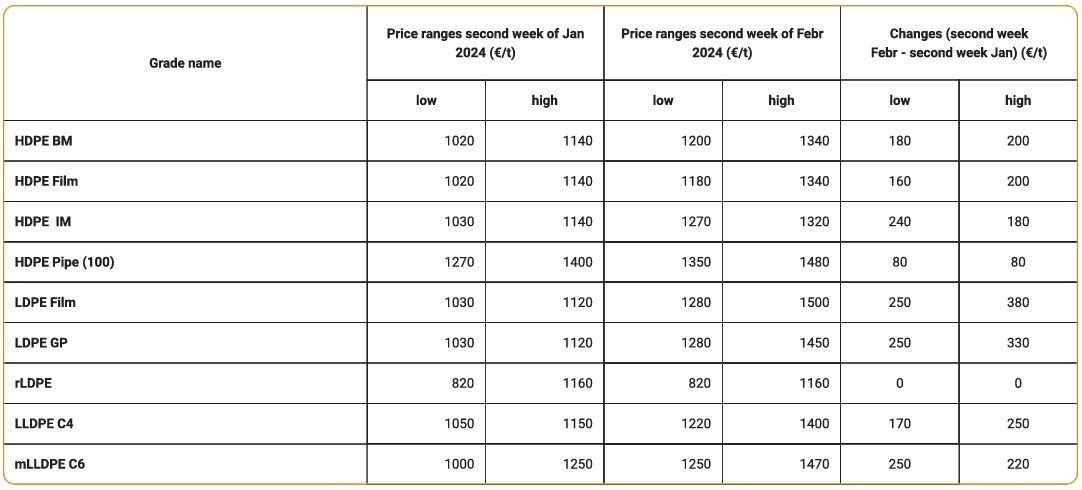Reasons for the polyethylene price increase in February 2024
Between January 2024 and February 2024, there will be a dramatic increase in polyethylene prices of EUR 200-380/t compared to the levels at the beginning of January 2024. The analytical company myCeppi consulting has provided information on the situation in the commodity plastics market.
The price changes for full truckloads are shown in the table below, which covers the period from the second week of January to the second week of February.
 | |
The reason for the price increases can clearly be traced back to the extremely limited supply. Behind the limited supply are, on the one hand, the planned and unplanned shutdowns of Central European polyethylene producers.
Ongoing maintenance / outages / malfunctions:
MOL Group - Slovnaft LDPE-4unplanned shutdown at the plant (220 kt/year LDPE capacity), the shutdown is expected to last 7-9 weeks. Due to the shutdown, the capacity of both the Bratislava Steam-cracker and the PP plant was reduced.
Rompetrol LDPEis still standing due to monomer supply problems at the plant (LDPE capacity of 60 kt/year), a restart is only expected if market prices ensure profitable operation from purchased ethylene. MOL Group LDPE- production problems at the plant of MOL Petochemicals in Tiszaújváros (65 kt/year capacity), production is expected to be restored already in February.
Expected maintenance / outages:
Orlen-Unipetrol HDPE planned shutdown in Litvínov from April 8, 2024 (270 kt/year capacity), the expected duration of maintenance is 30 days. Planned shutdown at in May, in Plock, (100 kt/year capacity) planned duration is 3 weeks.
HIP-Petrohemija LDPE HDPE planned maintenance in Pancevo between March 11 and April 25, 2024 (60 kt/year and 90 kt/year capacity affected)
In the case of the LDPE grades showing the largest price increase, all Central European production capacities are affected, the LDPE plants have either shut down or are preparing for maintenance. But a part of the HDPE plants, roughly 40% of the Central European capacities, are affected or will be affected by production restrictions.
Due to the deterioration of the security situation in the Red Sea, import shipments from the Middle and Far East are significantly delayed by 4-6 weeks. In addition, sea freight costs and container rental fees have increased significantly. This means a price increase of €100-200 per ton of imported polymer. In addition, the North American polyethylene producers not affected by the Red Sea crisis also implemented a significant price increase of $0.05/lb, i.e. more than €100. This especially affects LLDPE, HDPE and LDPE grades.
Western European polyethylene producers are also struggling with production problems. In fact, in the second week of February, all Western European manufacturers reported an “order stop”.
We expect the supply to expand gradually from the end of February. The arrival of the delayed import shipments is expected from that time. However, the supply will reach the usual level only in the second half of May, when the maintenance will be completed and the polymer stocks of the Central European polyethylene producers will be replenished.
- autor:
- László Bűdy


















